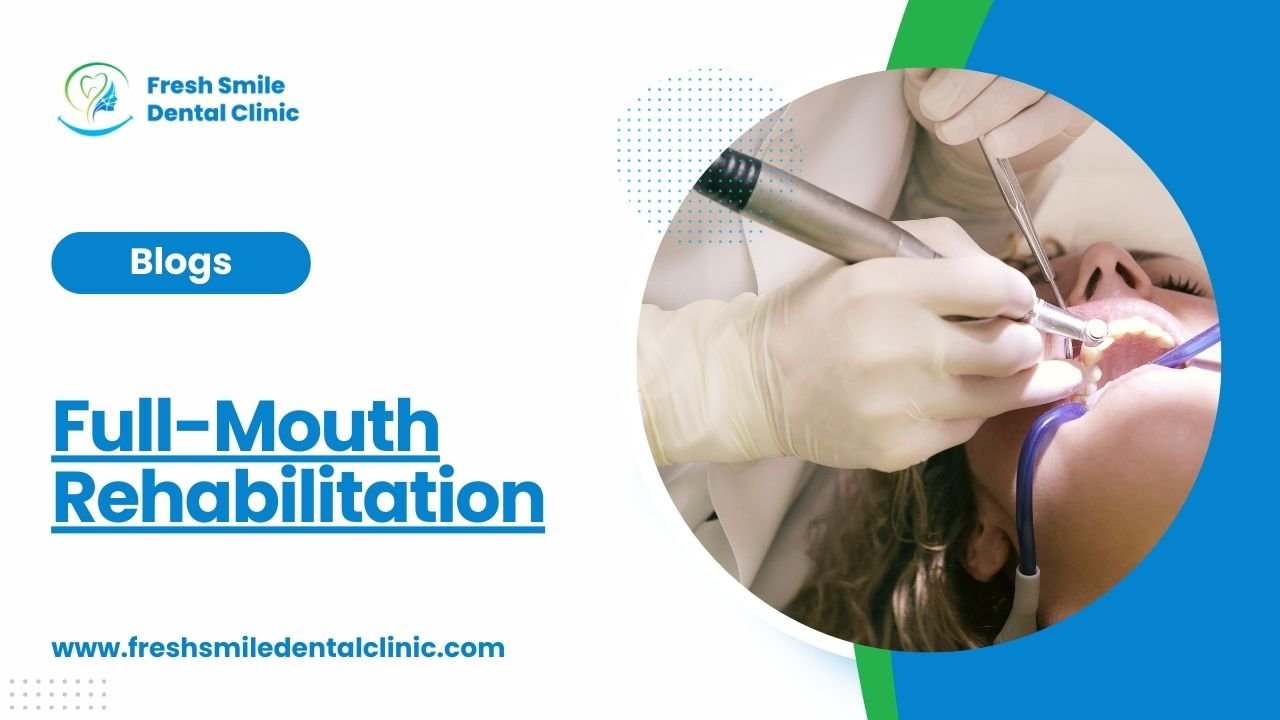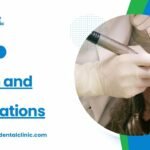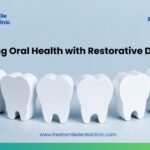Full-Mouth Rehabilitation: Your Path to a Healthy Smile
Your smile is a vital part of who you are, impacting your self-esteem and overall well-being. However, many individuals face oral health challenges that go beyond routine check-ups and cleanings. Full-mouth rehabilitation is a comprehensive approach to restoring your oral health, addressing a wide range of dental issues that may affect your teeth, gums, and bite. In this in-depth guide, we’ll explore the world of full-mouth rehabilitation in simple English, explaining what it is, when it’s needed, and the various treatments involved, all aimed at helping you regain a healthy and confident smile.
What Is Full-Mouth Rehabilitation?
Full-mouth rehabilitation, also known as full-mouth reconstruction or full-mouth restoration, is a comprehensive dental treatment approach that aims to restore the health, function, and aesthetics of all the teeth in a patient’s mouth. This type of treatment is typically reserved for individuals with extensive dental issues, such as:
- Severe tooth decay: When many teeth are affected by extensive cavities that cannot be effectively treated with traditional fillings or crowns.
- Tooth wear: This can be caused by bruxism (teeth grinding), acid erosion, or other factors, resulting in a loss of tooth structure and functionality.
- Trauma: Accidents or injuries that have caused significant damage to multiple teeth.
- Malocclusion: Problems with the alignment of the teeth and the bite, such as overbites, underbites, or crossbites.
- Periodontal disease: Advanced gum disease that has led to bone loss and loose teeth.
- Missing teeth: Gaps in the smile due to tooth loss, which can affect chewing, speech, and appearance.
The process of full-mouth rehabilitation typically involves a thorough evaluation by a dentist or prosthodontist, a specialist in restorative dentistry. The dentist will consider the patient’s oral health, the condition of their teeth and gums, and their specific concerns and goals. A treatment plan is then developed to address these issues comprehensively.
Common treatments and procedures involved in full-mouth rehabilitation may include:
- Dental crowns and bridges: These are used to repair and replace damaged or missing teeth, restoring both function and appearance.
- Dental implants: If teeth are missing, dental implants can be surgically placed to serve as artificial tooth roots, on which dental crowns can be attached.
- Orthodontics: Braces or clear aligners may be used to correct misaligned teeth and bite issues.
- Periodontal treatment: Scaling and root planing, gum surgery, or other procedures may be necessary to address gum disease and stabilize the foundation of the teeth.
- Dental veneers: Thin shells made of porcelain or composite material can be used to improve the appearance of teeth that are stained, discolored, or misshapen.
- Dentures: Partial or complete dentures may be used to replace multiple missing teeth.
- Endodontic therapy (root canal treatment): This may be necessary to save infected or damaged teeth.
The goal of full-mouth rehabilitation is to improve oral health, function, and aesthetics, helping patients regain their ability to eat, speak, and smile with confidence. The specific treatments involved in a full-mouth rehabilitation plan will vary based on the individual patient’s needs and goals. The process may require multiple appointments over an extended period, and the overall cost can be substantial, but the long-term benefits in terms of oral health and quality of life are significant. Patients should work closely with their dental care team to understand the recommended treatment plan and the associated costs and timeline.
When Is Full-Mouth Rehabilitation Necessary?
Full-mouth rehabilitation becomes necessary when you experience a multitude of dental issues that affect your oral health and overall quality of life. Some common situations that may warrant full-mouth rehabilitation include:
- Multiple Missing Teeth: If you’ve lost several teeth, this can impair your ability to chew and speak properly, and it can have a significant impact on your self-confidence.
- Severe Tooth Decay: Extensive cavities and tooth decay may necessitate full-mouth rehabilitation to save remaining teeth and restore your smile.
- Gum Disease: Advanced periodontal disease can lead to gum recession and tooth loss, making comprehensive treatment essential.
- Worn Teeth: Over time, teeth can become worn down due to grinding, clenching, or acid erosion, affecting both their function and appearance.
- Chronic Jaw Pain: Misaligned bites or temporomandibular joint (TMJ) disorders can lead to chronic jaw pain and headaches, requiring intervention.
- Aesthetic Concerns: Full-mouth rehabilitation can also address cosmetic issues, such as discolored, misshapen, or poorly aligned teeth.
The Comprehensive Treatment Approach
Full-mouth rehabilitation is a customized process that involves several dental procedures. The specific treatments you may undergo will depend on your individual needs. Some common treatments include:
- Dental Crowns: Crowns are used to restore damaged or decayed teeth, providing strength and protection.
- Dental Bridges: Bridges replace missing teeth, anchored by crowns on adjacent teeth, restoring both function and aesthetics.
- Dental Implants: Implants are surgically placed in the jawbone to replace missing teeth, providing a long-term, natural solution.
- Dentures: Full or partial dentures are used when multiple teeth are missing, offering removable options for tooth replacement.
- Gum Treatments: Periodontal treatments can address gum disease and improve gum health.
- Orthodontic Treatments: Braces or aligners may be used to correct bite problems and misaligned teeth.
- TMJ Therapy: Treatment for TMJ disorders can alleviate jaw pain and discomfort.
- Tooth Whitening and Cosmetic Procedures: Aesthetic concerns can be addressed with procedures like teeth whitening, veneers, and bonding.
The Role of Digital Technology
In modern dentistry, digital technology plays a crucial role in full-mouth rehabilitation. It enables precise planning, 3D imaging for implant placement, and the creation of highly accurate, custom dental restorations. This technology not only enhances the treatment process but also contributes to a more comfortable patient experience.
Chapter 5: The Benefits of Full-Mouth Rehabilitation
The advantages of full-mouth rehabilitation extend beyond just improving your oral health:
- Restored Functionality: You can regain the ability to eat, speak, and smile confidently.
- Enhanced Aesthetics: Full-mouth rehabilitation can transform your smile, boosting self-esteem.
- Pain Relief: It can alleviate chronic dental pain and discomfort.
- Preventing Further Damage: The comprehensive approach can prevent the progression of dental issues.
- Long-Term Solutions: Many full-mouth rehabilitation procedures offer long-lasting results.
- Improved Overall Health: Addressing oral health problems can positively impact your overall well-being, reducing the risk of systemic health issues associated with dental concerns.
What to Expect During Full-Mouth Rehabilitation
If you’re considering full-mouth rehabilitation, here’s what you can generally expect:
- Consultation: Your journey starts with a thorough examination and consultation with a qualified dentist or prosthodontist. They’ll discuss your goals and create a personalized treatment plan.
- Treatment Phases: Full-mouth rehabilitation often occurs in stages, addressing urgent issues first, followed by comprehensive treatment as needed.
- Multiple Appointments: Be prepared for multiple dental appointments to complete the various procedures involved.
- Recovery: Depending on the treatments, there may be a recovery period, during which you’ll need to follow post-operative instructions and maintain good oral hygiene.
Your Role in Maintaining Oral Health
After full-mouth rehabilitation, maintaining good oral health is vital to ensuring the longevity of the treatments. This includes practicing regular oral hygiene, attending follow-up appointments, and protecting your investment in your oral health.
The Importance of Initial Assessment
Before embarking on full-mouth rehabilitation, an in-depth initial assessment is crucial. This step involves a comprehensive examination of your oral health, including X-rays, impressions, and discussions about your dental history and goals. The assessment helps your dentist understand the scope of your dental issues, ensuring that the treatment plan is tailored to your specific needs.
Customization of Treatment Plans
One of the strengths of full-mouth rehabilitation is its customization. Every individual has unique dental challenges, and the treatment plan should reflect this. Your dentist will work closely with you to develop a plan that addresses your priorities, whether it’s restoring lost teeth, alleviating pain, or enhancing your smile’s aesthetics.
The Psychological Impact of Dental Issues
Dental problems can extend beyond physical discomfort. Many individuals who need full-mouth rehabilitation experience psychological stress and a decline in their quality of life due to issues like missing teeth or significant oral pain. Full-mouth rehabilitation not only restores dental health but also helps individuals regain their self-confidence and overall well-being.
Full-Mouth Rehabilitation vs. Piecemeal Approaches
It’s worth noting that full-mouth rehabilitation differs from a piecemeal approach, where dental issues are treated individually over time. While the latter might seem less overwhelming initially, it can lead to fragmented care and potentially higher long-term costs. Full-mouth rehabilitation offers a more comprehensive and efficient solution for addressing complex dental problems.
Patient Testimonials and Success Stories
Hearing from individuals who have undergone full-mouth rehabilitation can provide valuable insights. Sharing success stories and patient testimonials can help others understand the transformative power of these treatments, instilling confidence in the process and its life-changing results.
Financing and Insurance
The financial aspect of full-mouth rehabilitation is a significant consideration. Dental insurance coverage can vary, and some treatments may not be fully covered. Many dental offices offer financing options or payment plans to make these comprehensive treatments more accessible. Exploring these options can help you manage the cost of full-mouth rehabilitation effectively.
Exploring Non-Surgical Options
Full-mouth rehabilitation includes various surgical procedures, but non-surgical options are also available for certain cases. For example, Invisalign clear aligners can correct misalignment without traditional braces, offering a less invasive approach for improving your bite.
Addressing Dental Anxiety
Dental anxiety is a common concern for many patients, especially when considering extensive treatments like full-mouth rehabilitation. Dentists are well-equipped to manage dental anxiety through techniques such as conscious sedation or nitrous oxide, ensuring a more comfortable experience during the process.
Long-Term Maintenance
Once full-mouth rehabilitation is complete, the journey doesn’t end. Maintaining your oral health requires regular follow-up appointments, diligent oral hygiene, and protective measures to ensure the longevity of the treatments. Your dentist will guide you on the specific maintenance plan that suits your needs.
Conclusion for full mouth rehabilitation
Full-mouth rehabilitation is a transformative process that goes beyond just restoring your teeth. It can positively impact your overall well-being, self-confidence, and quality of life. By understanding its significance, customization, and the psychological aspects involved, you can make informed decisions about your dental health. With full-mouth rehabilitation, you’re not only investing in your smile but also in a brighter and healthier future.
Read Also:
Teeth and Gum Care for Infants and Toddlers.
Crown and Bridge Restorations.
Composite Fillings vs Amalgam Fillings.
Managing Dental Anxiety in Children.
Fluoride Treatments and Dental Sealants: Against Tooth Decay in Kids.
Treating Gum Disease with Laser Therapy.
Precision and Accuracy in Laser Dentistry.
11 things an adult can do to maintain good oral health.
11 things that makes your teeth weak.
11 Nighttime Tips for Maintaining Healthy Teeth and Gums.




